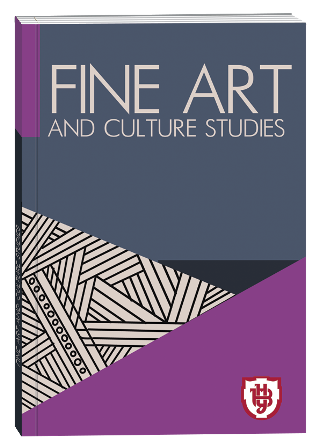АРХАЇЧНІ ІНДОЄВРОПЕЙСЬКІ ЕЛЕМЕНТИ МУЗИЧНИХ ФОРМ УКРАЇНСЬКИХ НАРОДНИХ КАЛЕНДАРНО-ОБРЯДОВИХ ПІСЕНЬ
DOI:
https://doi.org/10.32782/facs-2023-3-13Ключові слова:
філософія музики, індоєвропейський музичний ідіом, веснянки, гаївки, тетрахорди, етичні лади.Анотація
У статті здійснено аналіз музичних форм ряду стародавніх українських календарно-обрядових пісень, які своїми витоками сягають дохристиянської епохи та кількох знакових індійських сакральних музичних творів. Виявлено споріднені комплексні музичні структури, які ймовірно успадковані від спільного індоєвропейського музичного ідіому. Відзначено, що у кожному з цих творів застосовані ті чи інші лади, які Платон і Арістотель визначали як етичні, а також структурно споріднені з ними тетрахорди, яким ми дали назву дзеркально-симетричних етичним ладам. Так, у веснянці «Голубка» простежено дорійський та фрігійський лади. У гаївках «Кострубонько» та «Мак» – лідійський і дорійський лади, а також верхній тетрахорд дзеркально-симетричний лідійському ладові. У весільних піснях «Ой у саду голубець гуде», «Хміль лугами» та «Доля» – дорійський і лідійський лади, а також тетрахорди дзеркально-симетричні дорійському та фрігійському ладам. Виявлено, що в «Гаятрі Мантрі» двічі застосовується лідійський лад, а також присутній тетрахорд дзеркально-симетричний дорійському ладові, а у мантрі «Jai Radha Madhav» тричі використано фрігійський лад. У мантрі «Hari Hari Bol» простежено лідійський лад та тетрахорд дзеркально-симетричний фрігійському ладові. Також відзначено особливості поєднання тетрахордових структур. Підмічено, що у «Гаятрі Мантрі» композиція завершується лідійським ладом подібно до гаївки «Мак» та весільної пісні «Доля», які також закінчуються оплакувальним жіночим лідійським ладом, а у мантрі «Hari Hari Bol», як і у пісні «Ой у саду голубець гуде», дзеркально-симетричний фрігійському ладові тетрахорд переходить в лідійський лад. Також показано, що у цій мантрі фігурує дорійський ладовий відтінок поєднаний з верхнім висхідним тетрахордом дзеркально-симетричним дорійському ладові та вказано, що обернене явище спостерігаємо у пісні «Ой у саду голубець гуде», де верхній тетрахорд дзеркально-симетричний дорійському ладові плавно трансформується у дорійський лад. На основі дослідження вищевказаних музичних текстів, зроблено висновок, що метод структурного аналізу музичних форм є перспективним підходом для виявлення елементів успадкованих від спільноіндоєвропейького музичного ідіому.
Посилання
Грінченко Б.Д. Історія української музики. Київ: Спілка, 1922. 294 с.
Драганчук В.М. Музична психологія і терапія: навч. посіб. для студ. спец. «Музичне мистецтво» / В. Драганчук; передм. Л. Кияновської. Східноєвр. м. ун-т м. Лесі Українки, 2016. 230 с.
Драгоманов М.П. Вибране. Мій задум зложити очерк історії цивілізації на Україні / Упоряд. Р.С. Міщук, В.С. Шандра. Київ: Либідь, 1991. 688 с.
Зінків І.Я. Про один архетип української музичної культури: троїста музика. Вісник Київського національного університету культури і мистецтв. Серія: Музичне мистецтво, 2018. Вип. 1. С. 6–17.
Іваницький А.І. Історичний синтаксис фольклору: Проблеми походження, хронологізації та декодування народної музики. Вінниця: Нова книга, 2009. 404 с.
Карпенко А.П. Музичний катарсис як частина здоров’язберігаючих технологій навчання. Гуманітарний вісник. Педагогіка. 2012. №27 С. 116–120.
Колесса Ф.М. Шкільний співаник. Київ: Музична Україна, 1991. 217 с.
Колесса Ф.М. Ритміка українських народних пісень / Колесса Ф. Музикознавчі праці. К.: Наук. думка, 1970. С. 19–23.
Мішин В.Ю. Вчення про музичний етос у класичну епоху. Молодий вчений, 2018. №2. С. 537–542.
Назаров Н.А. Індоєвропейський музичний ідіом та етногенез індоєвропейців. Folia Philologica, 2021. №2. С. 42–60.
Carpenter, David Bailey, Whicher, Ian. Yoga: the Indian tradition. London: Routledge. 2003. P. 31.
Lear J. Katharsis. / J.Lear // Essays on Aristotle’s Poetics; ed. A. Rorty. Princeton: «Princeton university press», 1992. Р. 315–340.
Lükő, G. Zur Frage der Musikkultur in der slawischen Urzeit. Studia Slavica Academiae Scientiarum Hungaricae, 1964. № 3-4. P. 237–289.
Lyle, E. Wich Triad? A Critique and Development of Dumezil’s Tripartite Structure. Journal of the history of religions, 2004. №1. P. 5–11. 15. Radhakrishnan, S. Religion And Society. George Allen & Unwin LTD, 1947. 245 p.
Winter H, Gupta V. 30 and 1 Indian Mantras for Tongue Drum and Handpan: Play by Number. Independently Published, 2021. 38 p.
Young J.O. Assessing the Ethos Theory of Music . Disputatio, 2021. Vol. 13, № 62. P. 283–297 doi: 10.2478/disp- 2021-0015







